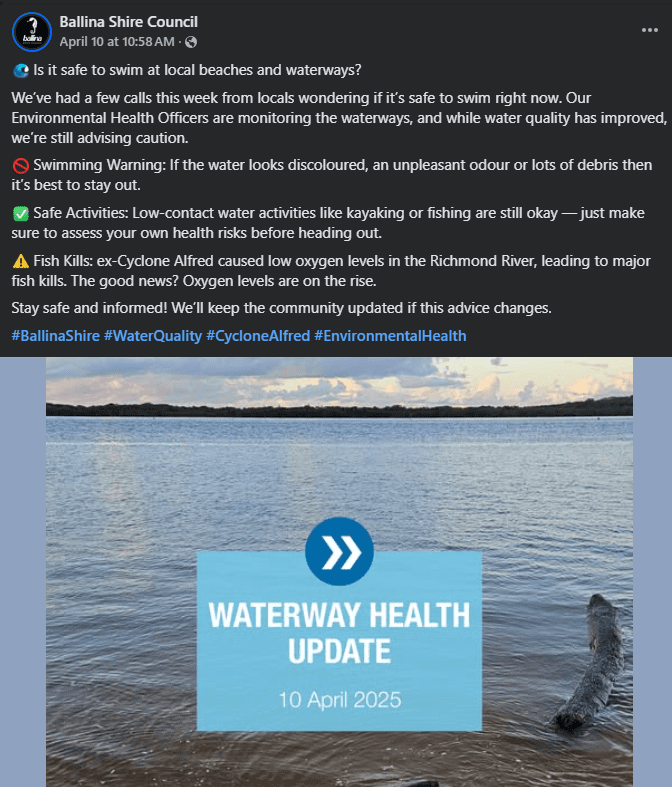- Fish Kill event related to the severe weather events is over, according to the DPI.
- Sewage leak is under investigation and ongoing testing is being conducted, says the EPA.
- For the latest water quality and beach condition information, refer to Ballina Shire Councils socials for the latest information.
The NSW Environment Protection Authority (EPA) has confirmed that water testing along the coast is ongoing. Ballina’s beaches are currently reported to be acceptable to use (with caution) despite the impacts of severe weather events, a whale carcass closing beaches, a substantial fish kill and Byron Shire Council reporting a large sewage leak into stormwater drainage.
A spokesperson from Ballina Shire Council said the council is collaborating with the Department of Climate Change, Environment, Energy and Water (DCCEEW) and the Environmental Protection Agency to conduct water sampling across several bodies of water.
Results show some sites are getting varied results. Council recommends checking the advice posted on their social media to ensure you have the latest information. The current advice is:
• Safe activities: Low-contact recreation such as kayaking and fishing is safe. Please consider your personal health circumstances before participating.
• Swimming: Avoid swimming if the water appears discoloured, has a strong odour, contains debris, or exhibits strong currents.
Council strongly advises the community to use caution and assess local conditions before engaging in recreational water activities. Water quality in Ballina Shire can vary significantly between beaches, rivers, and estuaries, and even day-to-day, influenced by factors such as rainfall, tides, and environmental changes.

The Department of Primary Industries (DPI) stated that, “The mass fish kill event in the Ballina region was driven by hypoxia (low oxygen levels) as a typical system response to major flooding of coastal floodplains. It has now passed, and no further investigations are ongoing.”
The DPI is appreciative of assistance and feedback from councils and communities over this time, and urge people to fish in healthy waterways and report any fish deaths or observations through the Fishers Watch phoneline on 1800 043 536.
In regards to the sewage issue, our oceans flow south along the coast in the East Australian Current. So we spoke to the EPA to discuss how potential effluent runoff in Byron could affect Ballina’s beaches.
We found that the claims made by Byron Shire Council have given the EPA cause for concern, and they are included in the ongoing investigation.
On April 14th, Byron Shire council released information explaining that almost a megalitre of sewage (about an olympic swimming pool) had escaped into the stormwater system between February 12th and 19th March. Council dealt with the problem and then contacted the EPA. (The cause is believed to be human error, although investigations have not been conclusive.)
“Extensive” water testing has been done at the discharge “to the ocean via Clarks Beach or Belongil Creek and all results at the time indicated there was no spill although it is impossible to determine if this was the case for the duration of the discharge.”
Christopher Soulsby, Manager Major Projects at Byron Council, said,“Council self-reported to the EPA as soon as we found out about the discharge, and since then we have been systematically checking our systems, collecting data and providing information to the EPA.”
However, an EPA spokesperson said, “Byron Shire Council has reported two recent sewer discharge events linked to the Sandhills Project, which involves temporarily bypassing the existing sewer line to build a new one.
“The EPA is conducting a thorough investigation into both discharges. This will include the response from the Council, including the delay in reporting these events to the EPA.
“Due to the heavy rainfall and large tides caused by ex-Tropical Cyclone Alfred, environmental impacts of the two discharges are likely to have been minimised.
“Community members are always encouraged to check with their local council for contaminated water updates after severe weather.”
The EPA reports that the first spill was quickly contained and largely recovered by Byron Shire’s efforts, and council’s water samples are being tested as part of their investigation. It is thought that “Tidal activity in the area would have flushed any remaining contaminants in the days following sampling.”
The second discharge had more serious consequences, it “flowed into a stormwater system connected to a creek that leads to the ocean. It continued for about three weeks and ended on 4 March 2025, but was not reported to the EPA until 10 April.
“Because of heavy rainfall from ex-Tropical Cyclone Alfred during this time, and the delay between the end of the discharge and the date it was reported, water sampling following this report would have been ineffective.”
At the time of ex Tropical Cyclone Alfred, there were numerous places reporting sewage discharges on the north coast. The EPA “has been conducting water quality testing in all rivers from the Clarence north to the Tweed. This aims to determine what impacts to water quality have been caused by the high rainfall and runoff from the Cyclone.
“As expected, regions impacted by the poor weather have shown some pollutants in waterways which will improve over time.”
Ongoing information is being supplied by the EPA to beachside councils to keep the community informed of water quality.
Byron Shire Council were not available for further comment. A link to Byron’s full media release is available here.



0 Comments